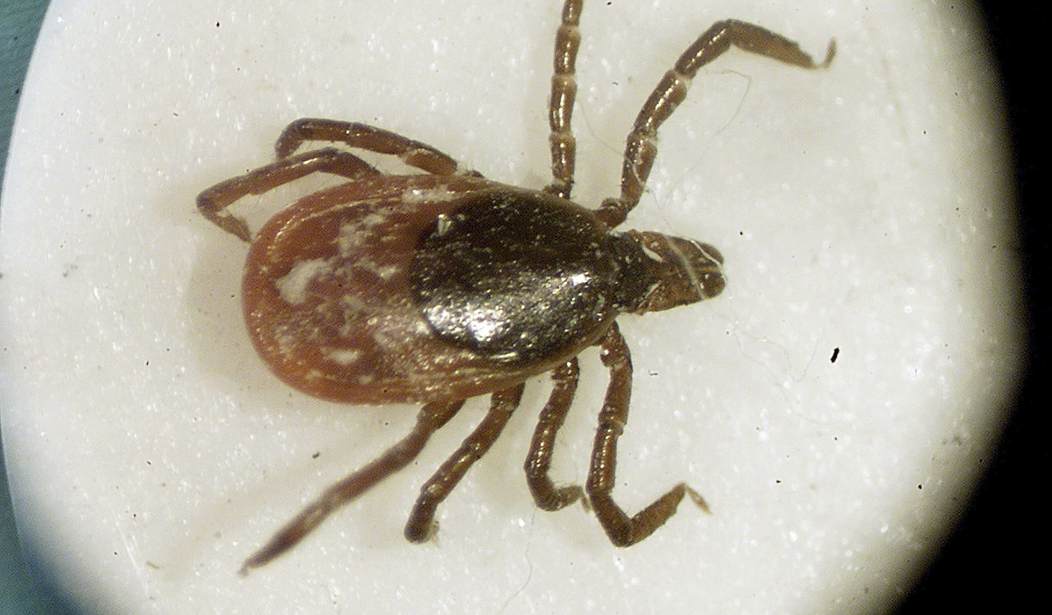A 58-year-old Missouri woman died last month after contracting a rare, tick-borne illness that was first discovered only three years ago.
Tamela Wilson, who had worked at a state park for more than 10 years, didn’t panic when she spotted two seed ticks on her skin in late May, according to CBS News. The assistant superintendent at Meramec State Park in Sullivan, Missouri, simply pulled the ticks off her body and went on with her day, unaware that she had contracted a deadly virus.
Just three days later, Wilson started to feel ill and went to see her primary care doctor, who diagnosed her with a urinary tract infection and gave her antibiotics. The next day, Wilson could barely function.
Missouri woman dies after contracting rare tick-borne Bourbon virus Tamela Wilson, 58, was the first person in… https://t.co/gx12rgFowW
— Eva (@savechihuahuas) July 13, 2017
“She literally couldn’t even pick up her phone. She had no strength,” Wilson’s daughter, Amie May, told CBS News. “My sister had been calling her and couldn’t get a hold of her. My mom said the phone was right there ringing, but she could not pick it up to answer it.”
Wilson then returned to her doctor and described having severe headaches, pain and a light red rash. After undergoing several tests, she was told she had a low white blood cell count and was admitted to Barnes-Jewish Hospital in St. Louis.
“They did a couple skin biopsies, but they came back fine,” May said. “They did other testing for tick-borne disease, but those were also negative.”
For days, Wilson and her children prayed for answers.
“They told us, you know, basically, they were hoping it would leave her system,” May said. “They would continue treating her symptoms and hope everything would go away on its own.”
But Wilson’s health continued to decline. She developed hemophagocytic lymphohistiocytosis (HLH), a condition affecting her immune cells. The rash spread to other parts of her body, even her mouth.
“I’m a nurse and I’ve never seen anything like I’d seen my mother’s mouth,” May said. “It got so bad toward the end she couldn’t talk, couldn’t drink, couldn’t eat — nothing.”
Infectious disease specialists sent Wilson’s blood work to the Centers for Disease Control and Prevention (CDC), which confirmed Wislon had Bourbon virus, an extremely rare tick-borne illness that was first identified at a University of Kansas hospital in 2014.
Bourbon virus is named after Bourbon County, Kansas, home of the first person who died of the disease in the summer of 2014. Wilson is the fifth confirmed case of the deadly disease since it was first discovered, doctors say. According to the CDC, there is not yet a treatment for the virus.
Wilson’s daughter said: “It’s viral. There isn’t anything you can do. It just has to run its course.”
Wilson lost her battle with the virus on June 23, about three weeks after she was admitted to the hospital.
Dr. Christopher Braden, an epidemiologist with the CDC, told CBS News that cases of the most common tick-borne illness, Lyme disease, have tripled in the U.S. In 2001, there were about 17,000 confirmed cases of Lyme, but in 2015, the number reached almost 30,000 — and experts say the actual number is likely much higher.
Ticks can also spread less common but dangerous infections like Rocky Mountain spotted fever, Heartland virus and Powassan virus.
“I was somebody, like, I didn’t really give much attention to a tick bite. You get a bite, pull it out and go about your business,” May said. “You don’t think about complications coming from a tick bite. As far as I know, other tick-borne diseases are treatable. That’s what’s scary about this one — you don’t know if you’re gonna make it or not.”
Scientists from the CDC were dispatched to Meramec State Park in the wake of Wilson’s death, to collect ticks and study what happened, KY3 reported:
https://youtu.be/1gn7MlG7cTk
Experts recommend using insect repellent — Permethrin or DEET — if you are going to be spending time outdoors, especially in wooded areas. Permethrin is an insecticidal compound produced by the chrysanthemum flower that is commonly used to treat lice. If you put it directly on the skin, typically less than one percent of the active ingredient is absorbed into the body. DEET, on the other hand, can be absorbed at over 20 times that rate, according to the Tick Encounter Resource Center.
TERC recommends that you treat your shoes with permethrin every month throughout the spring and summer because the nymphs get on you by latching onto your shoes and climbing up your foot and leg.
How effective is it?
- It has been used as a clothing treatment to prevent bites from ticks, flies, and mosquitoes since the 1970s, and used by the military since the 1990s.
- It provides a quick tick knock-down effect – both repels and kills.
- A URI study found that people wearing permethrin-treated sneakers and socks were 73.6 times less likely to have a tick bite than those wearing untreated footwear.
- Each at-home treatment lasts for roughly 3-4 weeks (with washing!).
- Commercially treated clothes can last up to 70 washes.
If you live in Missouri, like I do, this one’s a no-brainer. Just do it.









Join the conversation as a VIP Member